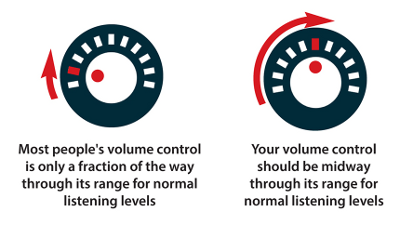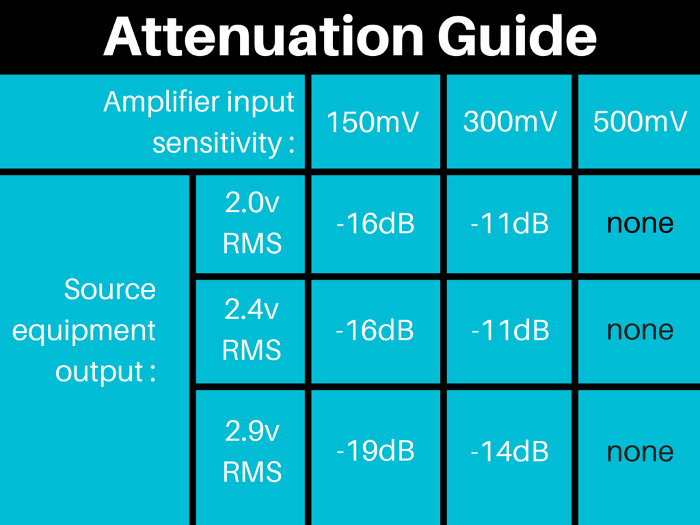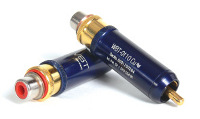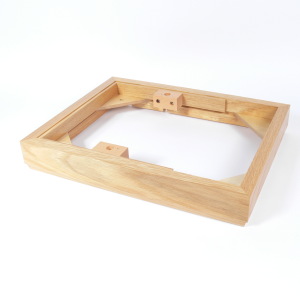What is Attenuation?
The Problem
Do you find that you have very little control over your volume? Do things start to get too loud when you are only using a small part of the range on your volume dial? If so, it's likely that you will benefit from an attenuated interconnect. Read on to find out...
The best input sensitivity for an amplifier (to allow for full dynamic range, differences in recording level etc) is 500mV (half a volt). This sensitivity works very well with no input overload and has a good range of control on the volume control. In practical terms this means that, for normal listening levels, the volume control should be in the centre region of its range (12 o’clock on a clock face). This allows you the flexibility to play your music very quietly up to very loud depending on your mood. The trouble is that most people’s volume control is only a fraction of the way through its range for normal listening levels (see diagram below).
The standard CD/DVD output voltage is 2 volts. Most people find that they can only use the volume control up to 8 or 9 on the clock face scale because many amps are now designed with 300mV or even 150mV input sensitivity. This produces what I call ‘dynamic overload’.

The Effect
The effect of dynamic overload is to reduce dynamic range, mask differences in the music, cables, mains, support etc, flatten the soundstage from 3 to 2 dimensions, add bright hardness (or sometimes dullness) and reduce bass extension. Worst of all, it takes the musicality out of the music.
The volume control is just like a water tap, the number of turns varies the amount of water you get. The pressure of water controls how many turns of the tap are required (the water pressure is equivalent to voltage in electronics.) We have all probably experienced the effects of too high a water pressure in a wash basin! To cure it, all you need do is fit a pressure control valve (an attenuator) on the pipe to turn the pressure down.
On a preamp or integrated amp the volume control just acts as a tap for the volume. The last thing you want is overload, so you must reduce the voltage (pressure) to the volume control (tap) with a resistor attenuation network.
The Solution

The solution to the overload problem is to reduce the voltage level of the source output by the using our attenuators.
These are available fitted (a tiny network is fitted inside the Phono/RCA plug) to nearly all KIMBER interconnects with the exception of Balanced (we currently do not offer an attenuation option for balanced/XLR cables) and the Select range.
Once the overload problem is cured you will hear increased dynamic range, increased dimensionality, smoother sweeter treble, deeper bass and, above all, much more musicality. You will also find that you can now use much more of the range of the volume control.
What level do you need?
To work out what level of attenuation you need, find out what the input sensitivity of your amplifier is (often printed in the specs as a mV figure.) Then find out what the output level of your CD player is - usually 2 volts.
Now consulting the chart below read across to find out what attenuation you need. So, for example, a CD player with a 2V output and an amplifier with 300mV input would need an attenuation level of -11dB.

Attenuator Options
There are two ways you can attenuate your cable. First, you can add a level of attenuation to your cable when you purchase it. If a cable has attenuation as an option you will be able to select the level you need in the box shown here. If you already own a pair of Kimber or Russ Andrews interconnects, you can have them ‘retro-fitted’ with attenuation - call us for details.
If this is not shown as an option, don’t worry because we also produce an in-line version which can be used with any make or model of interconnect, including Kimber’s Select range.
 Here, the components are fitted into high quality WBT locking phono plugs to minimise any effects of adding another link into the signal path. Remember, any small loss this creates will be vastly outweighed by reducing dynamic overload.
Here, the components are fitted into high quality WBT locking phono plugs to minimise any effects of adding another link into the signal path. Remember, any small loss this creates will be vastly outweighed by reducing dynamic overload.Buy our inline attenuators.






















